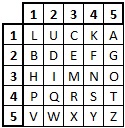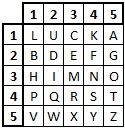Other ways to alter Fractionated Ciphertext
Another way to alter the numbers after we have fractionated the text is to add (or subtract) something to each number after the fractionation. This changes the identity of each digit and so the letters they represent. We shall look at the simple plaintext "a simple example", and we shall use a standard Polybius Square with no key. Using this we get the string of digits "11 344223531351 51351123531351". We can now add to each digit any number we like, we shall add 2. Obviously, if we add 2 to 5 we get 7, and we cannot use this in the Polybius Square, so we have to take each number modulo 5, that is a 6 becomes a 1, a 7 becomes a 2 etc (not strictly modular arithmetic in this case, but there is no 0 so we modify slightly).
We now use the Polybius Square to turn this back into the ciphertext "N EQYWXM MKNYWXM". However, notice that this is simply a monoalphabetic substitution.
We can get round this by adding a different digit at each point, and in this case the number we are going to add is our key.
Encryption
To encrypt we first turn our plaintext into a string of digits using the fractionation method of choice. We then repeat the key number beneath this string until it is the same length as the fractionated digits. We add or subtract the key digit to/from the fractionated digit, and take the number we get to the correct modulo. If using a Polybius Square, this is the number of columns. If using a Straddling Checkerboard it is always modulo 10.
To encrypt we first turn our plaintext into a string of digits using the fractionation method of choice. We then repeat the key number beneath this string until it is the same length as the fractionated digits. We add or subtract the key digit to/from the fractionated digit, and take the number we get to the correct modulo. If using a Polybius Square, this is the number of columns. If using a Straddling Checkerboard it is always modulo 10.
As an example, we shall encrypt the plaintext "escape now" with keyword luck and key number 9274.
Now we have the fractionated digits, we write out the key number 9274 repeating beneath these digits, and add down each column. Finally we take each of then totals modulo 5 to get the final digits.
With this string of digits we now convert back to ciphertext using the same Polybius Square to get "QHIWAA XDB".
Notice that the two "e"s in the plaintext encipher to "Q" and "A", and also that the "pe" in "escape" encodes to "AA". This is clearly not a monoalphabetic substitution cipher now.
In the second example, we shall encrypt the plaintext "when shall we meet?" using a single keyword secret and a Straddling Checkerboard (with key numbers 1 and 7). We shall subtract this time.
Now we need to convert the keyword secret into a key number. To do this, we simply replace each letter by the number which represents it. So a becomes 0, b becomes 1, etc. Doing this gives us 184217419. We then repeat this under the fractionated digits, and take the key digit from the fractionated digit in each column. We then take these modulo 10.
Finally we convert these back into the ciphertext using the same Straddling Checkerboard to get "#8PB#7B#5AURYTRRA T R", or omiting the numeric escapes we get "8PB7B5AURYTRRA T R".
Decryption
The decryption process is identical to the encryption process, except we use the inverse operation. That is, if we added whilst enciphering, then we subtract in deciphering, and vice versa. We shall see that this works using the same two examples from above.
The decryption process is identical to the encryption process, except we use the inverse operation. That is, if we added whilst enciphering, then we subtract in deciphering, and vice versa. We shall see that this works using the same two examples from above.
With the fractionated digits, since we added the key to encrypt, we must subtract the key to decrypt, which gets us the following.
Finally, we must convert this back to plaintext using the Polybius Square to get "escape now".
Similarly, with the ciphertext "8PB7B5AURYTRRA T R", knowing we used a Straddling Checkerboard with key numbers 1 and 7, and a single keyword of secret. We start by again converting this to digits using the Straddling Checkerboard.
We then use the keyword converted into a key nnumber, and add the digits together, before taking the answer modulo 10.
Finally we convert this back into plaintext using the Straddling Checkerboard "when shall we meet".
Discussion
In many ways this is a much easier process that the Transposition of Fractionated text, especially if doing it by hand. However, the level of security is similar, since you are still manipulating the components of each letter individually.
In many ways this is a much easier process that the Transposition of Fractionated text, especially if doing it by hand. However, the level of security is similar, since you are still manipulating the components of each letter individually.
As with transposing fractionated text, it is possible that the very last digit could be one of the key numbers in the Straddling Checkerboard. This is dealt with in the same way, and we insert "^" before the number, and then a 0 on the end to give us an actual letter. When decrypting, if we see a "^", we know to ignore the very last digit.
Unfortunately, as with the Vigenère Cipher, the repeating nature of the key number is the biggest weakness here. We can help avoid some of this by using a non-repeating sequence of numbers, such as the decimal expansion of π.
As with transposition ciphers, it is also possible to iterate the process more than once. That is, you could add on the key number several times. This does not really make the cipher much more secure, as you are still just adding a number to each digit, but does make it hard to break by pen and paper methods.
Questions
1. Encrypt the following messages using the given ciphers, alphabet and keys in brackets
(a) "Meet me at the docks" (Polybius Square with addition, standard alphabet of 26 letters combining "i" and "j", keyword = james)
(b) "True wisdom is knowing you know nothing" (Straddling Checkerboard with Myszkowski Transposition, standard alphabet with numeric escape and space, Checkerboard keyword = estoniar, Transposition keyword = socrates, key numbers = 3 and 8)
2. Decrypt the following ciphertext messages using the given ciphers, alphabet and keys in brackets.
(a) "LNEFUUMACAETPHESQQOUXMKCRANCES" (Polybius Square with Permutation, standard alphabet of 26 letters combining "i" and "j", Polybius keyword = square, Permutation keyword = circle, with null key 1)
(b) "I EY 3IEQLF LENN IETAPFSTITABTHESIN FGNTHPESQINSASGPE L N SAIIMNW" (Straddling Checkerboard with Columnar Transposition, standard alphabet with numeric escape and space, keyword = einstein, key numbers = 1 and 5)
1. Encrypt the following messages using the given ciphers, alphabet and keys in brackets
(a) "Meet me at the docks" (Polybius Square with addition, standard alphabet of 26 letters combining "i" and "j", keyword = james)
(b) "True wisdom is knowing you know nothing" (Straddling Checkerboard with Myszkowski Transposition, standard alphabet with numeric escape and space, Checkerboard keyword = estoniar, Transposition keyword = socrates, key numbers = 3 and 8)
2. Decrypt the following ciphertext messages using the given ciphers, alphabet and keys in brackets.
(a) "LNEFUUMACAETPHESQQOUXMKCRANCES" (Polybius Square with Permutation, standard alphabet of 26 letters combining "i" and "j", Polybius keyword = square, Permutation keyword = circle, with null key 1)
(b) "I EY 3IEQLF LENN IETAPFSTITABTHESIN FGNTHPESQINSASGPE L N SAIIMNW" (Straddling Checkerboard with Columnar Transposition, standard alphabet with numeric escape and space, keyword = einstein, key numbers = 1 and 5)








